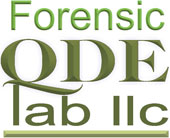Questioned Document Examination
Just about everyone has at one time or another expressed an opinion about something, only later to regret being quite so bold when circumstances change or the opinion is no longer valid. That’s okay in everyday life, and most of the time people will accept that kind of turnabout. But flip-flop doesn’t work well for an expert witness.
Testimony of expert witnesses can literally affect the course of action by a judge or jury. So when a handwriting expert like me identifies a writer, there should be virtually no doubt about that opinion. Besides needing the proper training to be able to weigh the features of the handwriting, an expert should have sufficient evidence in both quality and quantity upon which to base a definitive opinion. Anything less warrants a limited conclusion.
How does a document examiner express limited conclusions, you ask?
For the ans wer to that, we turn to the guidelines provided to us by the American Society for Testing and Materials, International – known to most as ASTM. ASTM has established guidelines for all types of manufacturing and consumer goods and services and is recognized worldwide as a source for standardized practices.
wer to that, we turn to the guidelines provided to us by the American Society for Testing and Materials, International – known to most as ASTM. ASTM has established guidelines for all types of manufacturing and consumer goods and services and is recognized worldwide as a source for standardized practices.
The ASTM provides nine levels of certainty to help define what I mean by what I say. Let’s use an example, a case involving the identity of a writer. There are four levels of certainty for identifying a writer, four levels of certainty for elimination of the writer and an inconclusive level in the middle designated as “cannot identify or eliminate.” The first four levels of certainty for identification outline how to express a positive opinion. Similar criteria can be applied to the elimination of a writer.
The Levels of Certainty Explained
Identification – The expert has no reservations that the known writer wrote the questioned writing. In criminal courtroom terms, this might be considered similar to “Beyond a Reasonable Doubt.”
Highly Probable – The expert is virtually certain that the known writer wrote the questioned writing; however, some critical feature(s) is missing for identification. This compares to “Clear and Convincing Evidence” and is a very strong opinion.
Probable – The expert has found some unexplainable differences within the comparable evidence, but it is likely that the known writer wrote the questioned writing. This is the approximate equivalent to “More Likely than Not” court standard.
Indications – The productivity of this examination is limited by the quality or quantity of comparable evidence. The writing has few features which are significant for comparison purposes, but those features are in agreement with the questioned writing. This level is significantly lower than “Preponderance of the Evidence” standard.
The Expert’s Interpretation
It is up to the experience and training of the Forensic Document Examiner to determine the significance of the matching features between writings and if any differences between the writings are fundamental to the questioned writer or merely unexplainable due to a lack of sufficient sample writings. Once all of the features, characteristics and nuances of the writing are identified, compared and weighed, an appropriate opinion can be rendered.
Just because the expert cannot reach an opinion of absolute identity or elimination, does not necessarily cast doubt on the abilities of the expert. On the contrary, it most likely indicates that there is a lack of adequate quality or quantity of evidence to support such an opinion. Quite often this is the direct result of having only copies to examine.
Coming up, I will discuss some of the many shortfalls of using copies as evidence.
